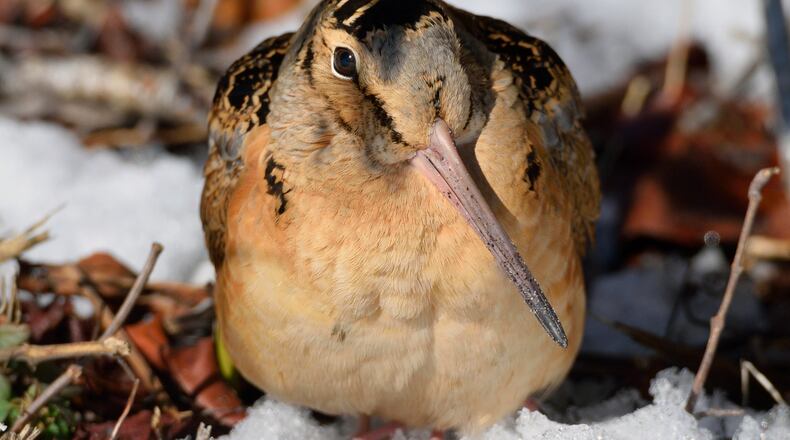Really wrong.
What is this thing?
The American Woodcock is approximately softball-sized with understated brown plumage that is perfect camouflage for the damp, new-growth, forest floors where they live. Outwardly, they look like a shorebird that forgot to grow its legs. Males and females are essentially identical. You have to look closely, but that’s where the understatedness ends.
Unlike nearly every other animal in the world, their eyes are situated behind their ears. That enables them to see danger above while their long beak (more on that later) is sunk deep into the soft soil probing (and possibly listening) for earthworms that make up the vast majority of their diet. Often they rock back and forth, somehow causing invertebrates underground to give up their location and become dinner. I’m saying dinner because they’re primarily nocturnal and that meal seems to align best.
About that beak
A woodcock’s beak has a prehensile tip. Imagine a long skinny pair of needlenose pliers, but where the last third of one side includes an additional hinge and you’re close to the idea. That hinge enables the beak to operate deep in the moist soil and grab worms underground.
Interestingly, you can tell the difference between the sexes by the length of their bills and a U.S. dollar bill. Males' beaks typically are less than the width of a US paper currency, females’ will extend beyond the edge
How to see them
Woodcock depend on their camouflage, nocturnal nature and lack of movement to avoid detection by predators. If you haven’t seen one, those are probably the reasons why. They are very good at all of those things.
They also migrate from the north to the south in the winter, to lands where unfrozen ground enables them to use that special beak.
How then, if they’re either migrating or remaining still and nearly invisible, are they supposed to find and attract a mate? That’s where the weird behavior and timing come in.
It starts with a “peeennnt” at dawn and dusk. As strange as it is to write that — when you hear it you’ll know. It describes it perfectly. In Ohio, start listening at the end of February into the beginning of March, especially after a strong southerly wind and the ground isn’t frozen. The sound will repeat several times, then in a fluttering cross between whistling and wiring wings, the male takes flight in a broad loop.
The loops will get continuously tighter and the pitch increase as the male gains altitude. Then in the penultimate act, corkscrews back to earth in tight loops and twittering sound to about where he started.
It’s truly something to see, especially for a female woodcock.
Where to see them
There’s a good chance that you’ve been much closer to a woodcock than you think. I’ve found them in small pockets of scrubby brush next to new housing builds, in fields, and along fence rows. You have to be outside and listening before first light or just at dusk.
Listening is the key. Because they’re migrating through southwest Ohio, so is timing.
The return trip
These same birds, without the magical dance, will migrate back through in the fall. Not having the most aerodynamic design, they are not especially fast fliers or long fliers. In fact, the slowest recorded flight by a bird was a woodcock at 5 miles per hour. But they are maneuverable.
The fact that remaining still is their first line of defense, rather than running or flying makes them a great quarry for pointing dogs. Cocker Spaniels incidentally were bred specifically for the pursuit of these birds. By most accounts, that instinct is missing from the breed today.
If anyone is using these dogs for their intended purpose in Ohio, I’d love to hear from you.
In the meantime, get up early or out at dusk and listen for woodcock. You could catch a glimpse of an exotic bird right here in Ohio.
Devin Meister is a local outdoors and wildlife enthusiast and has a blog called “Average Guy Outdoors.” He is an Ohio University graduate. Reach him at meister.devin@gmail.com.
MORE DETAILS
There are a variety of websites where you can track the migration of tagged birds to know when you’re chances of seeing them are best, including woodcockmigration.org. For local youngsters, Dayton Five Rivers Metro Parks is holding a Woodcock Walk on March 15. Check the events on their website for details and to register. Additionally, various Ohio state parks hold similar events.
About the Author

